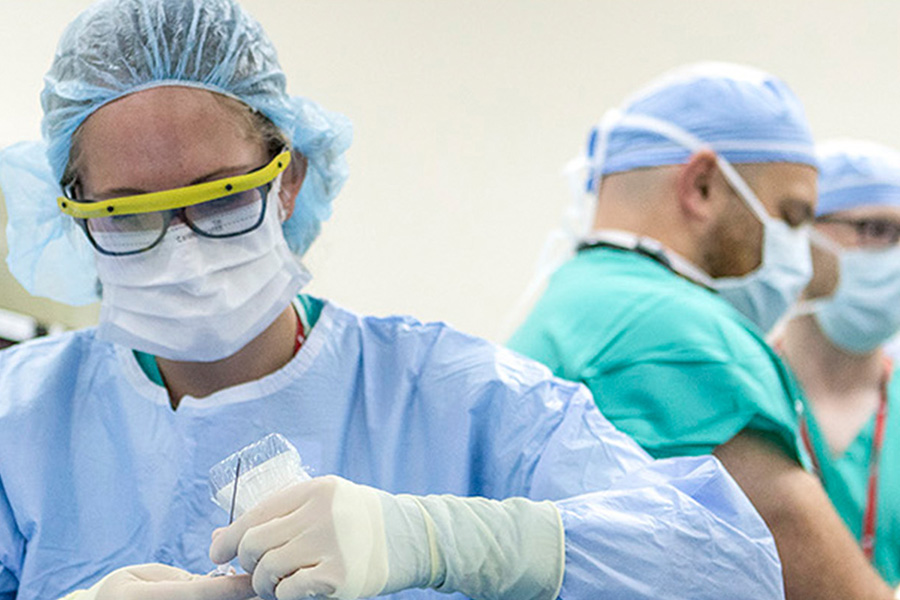Clinical Rotations

Our residency's clinical rotation schedule offers flexibility for elective rotations and personal needs.
To learn more about our program, visit the Testimonials and Tours page for a look at the structure and culture of our program from a resident perspective or download the Residency Applicant Handbook for complete program details.
Our Clinical Base Year (CBY) provides a unique blend of rotations specifically chosen to prepare our residents for their future in anesthesiology and care of the patient in the perioperative period. Our year is distinctive in that you will work with private practice physicians and academic departments.
On private practice rotations, you will often be the only resident working one-on-one with the attending faculty while receiving extensive clinical experience with personal didactic instruction and guidance. Academic rotations bring opportunity to develop very important team skills, as you will be a member of the team of residents covering a particular service, and participate in that department’s structured didactic programs. In the CBY year, you will learn to function with varying levels of autonomy, and you will continue the process of assimilating into the role of a physician.
The rotations include:
- Anesthesiology
- Cardiology (private practice and Nebraska Medicine)
- Critical Care (Anesthesiology and Trauma Surgery)
- Emergency medicine
- General surgery
- Internal medicine (inpatient and consult service)
- Nephrology
- Otolaryngology (2 weeks)
- Acute pain service (2 weeks)
- Chronic pain service (2 weeks)
- Transfusion medicine (2 weeks)
The Clinical Anesthesia 1 (CA1) year focuses on establishing general anesthesia skills in the operative setting with at least one month of Critical Care Anesthesiology (CCA). CA1 residents care for a wide range of patients, from outpatients to some of the most critically ill patients imaginable.
Rotations include:
- Ambulatory surgery
- Subspecialty introduction: Cardiothoracic, multispecialty, acute pain management
- Anesthesia out of the OR
- Basic echocardiography
- Orthopedic surgery
- Preoperative anesthesia screening clinic
The Clinical Anesthesia 2 (CA2) year builds upon the foundation of the CA1 year, but focuses on subspecialty rotations and more challenging care including:
- Airway techniques (VA)
- Cardiothoracic anesthesiology
- Critical care anesthesiology
- Pediatric anesthesiology
- Multispecialty anesthesiology
- Neuroanesthesiology
- Obstetric anesthesiology
- Anesthesiology for transplant surgery
- Anesthesiology for thoracic and vascular surgery
- Postoperative recovery unit anesthesia
- Pain Medicine, including chronic pain management, and regional anesthesia and acute pain management
The Clinical Anesthesia Year 3 (CA3) offers advanced experiences in general and subspecialty anesthesia as well as the opportunity to pursue elective rotations selected by each resident. Options include:
- Advanced airway techniques
- Additional subspecialty experience
- Private practice rotation, Bryan West Medical Center
- Perioperative practice management
- Research rotations
- Global Health elective in Lusaka, Zambia
Case Logs
| RRC Procedure | RRC Minimum | Program Average | National Program Average |
|---|---|---|---|
| Total Cardiac | 20 | 87.1 | 54.2 |
| Total Cesarean Section | 20 | 38.9 | 65.1 |
| Total Epidural | 40 | 127.9 | 106.6 |
| Total Intracerebral | 20 | 47 | 36 |
| Total Intracerebral Open | 11 | 37.5 | 28.8 |
| Total Intrathoracic non-cardiac | 20 | 38.6 | 31.8 |
| Total Pain Evaluation - New Patient | 20 | 60.7 | 55.5 |
| Total Peripheral Nerve Block | 40 | 255.9 | 181.4 |
| Total Spinal | 40 | 59.9 | 66.2 |
| Total Vaginal Delivery | 40 | 83 | 94.2 |
| Total Vascular, major vessels | 20 | 87.6 | 52.1 |
| Total Life-Threatening Pathology | 20 | 85.8 | 70.6 |
| Patients < 3 months | 5 | 9.6 | 9.1 |
| Patients < 3 years | 20 | 106.8 | 58.4 |
| Patients < 12 years | 100 | 242.2 | 146.6 |